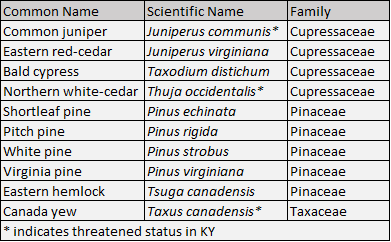Conifers of the Walk Across Kentucky
Conifers of the Walk Across Kentucky

Due to the warm weather we’ve had in the past month, we’ve been seeing annual plants germinating, early spring bulbs pushing through the soil, and even a few maple buds breaking. However, it is still winter in Kentucky, and the greenest parts of the landscape are still the evergreens. Evergreens fit under the definition of conifers, which are woody trees or shrubs that have needles as opposed to broad leaves. Additionally, the term conifer means “cone-bearer” – they have cones, which are scaly fruits that produce seeds.
 The Walk Across Kentucky (WAKY) is home to nine of the 10 conifers native to Kentucky (see table). These conifers fit into three plant families: Cupressaceae (the cypress family), Pinaceae (the pine family), and Taxaceae (the yew family). The state-threatened Canada yew (Taxus canadensis; pictured) is the only Kentucky native conifer not represented in our collection. It is related to the popular landscape plant, the English yew (Taxus baccata), and has an extensive range in northeastern North America. In Kentucky, however, it exists only in small and fragmented populations in the Appalachian Plateau and is considered a possible glacial relict.
The Walk Across Kentucky (WAKY) is home to nine of the 10 conifers native to Kentucky (see table). These conifers fit into three plant families: Cupressaceae (the cypress family), Pinaceae (the pine family), and Taxaceae (the yew family). The state-threatened Canada yew (Taxus canadensis; pictured) is the only Kentucky native conifer not represented in our collection. It is related to the popular landscape plant, the English yew (Taxus baccata), and has an extensive range in northeastern North America. In Kentucky, however, it exists only in small and fragmented populations in the Appalachian Plateau and is considered a possible glacial relict.
All of our trees in the pine family can be found in the Appalachian Plateau region of the WAKY. The only Kentucky native conifer that is not a pine (in the genus Pinus) in this family is the eastern hemlock (Tsuga canadensis; pictured). This beautiful tree is a slow-growing, long-lived conifer with small cones and great ecological importance. In ecological terms, eastern hemlock is a foundation or keystone species, meaning that its presence in an ecosystem has significant effects on the surrounding flora and fauna. The tannins in its needles alter stream dynamics and understory species diversity, and its branches provide homes for various birds, insects, and arachnids. However, eastern hemlock is being severely threatened across its range by an invasive insect, the hemlock woolly adelgid. Hemlock woolly adelgid has not been found on any of our 20 specimens, but we sometimes see a different invasive pest, the hemlock elongate scale.

The Cupressaceae family contains cedars, junipers, and the bald cypress (Taxodium distichum). Bald cypress is our one native conifer that is not an evergreen – it is a deciduous conifer, meaning that its leaves (needles) turn a coppery orange and fall in the autumn, alongside the leaves of our broadleaf deciduous trees. This impressive tree is found in many areas of The Arboretum. It loves wet soil and is typically found in swamps but can tolerate a variety of conditions, making it a nice choice for the landscape.
The common juniper (Juniperus communis; pictured), has a variable and extensive range across the northern climates of the world, but has been observed in just two counties in Kentucky, on sandy cliff edges and adjacent woodlands. We have one specimen of this special plant in our collection, which grows as a shrubby and contained juniper. Our other native conifer in the genus Juniperus, eastern red-cedar (Juniperus virginiana; pictured), is significantly more common, popping up in fields, dry woods, and limestone glades across Kentucky.
There is one conifer that is decidedly not native to Kentucky in the Mississippi Embayment region of the WAKY, which is the dawn redwood (Metasequoia glyptostroboides). Another deciduous conifer, this tree was known only in fossil records until 1946 when it was discovered in the wild in China’s Hubei province. The Arnold Arboretum of Harvard University received seeds in 1948, shared them with gardens and universities around the world, and the dawn redwood became a prominent landscape plant. We keep this tree in the WAKY because it is a valuable teaching tool and has an interesting story.
